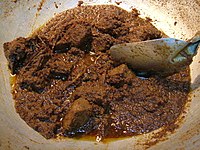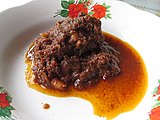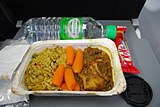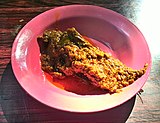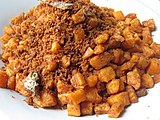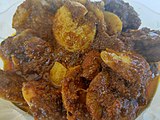Rendang/ja: Difference between revisions
Created page with "料理歴史家のジャネット・P・ボアローによると、ポルトガル人料理人は、煮込み後に肉を揚げるという独特の調理法を持っており、これは煮る前に揚げるというアラブの技法とは異なっていた。このルソ・アジア人料理人によって採用された方法は、ルンダンを含む現地の料理慣習に影響を与えた可能性がある。:en:Portuguese Malacca|ポルトガルがマラッ..." |
Created page with "マラッカがオランダに陥落した後、マラッカのポルトガル人入植者の子孫であるクリスタン共同体は経済的困難に直面し、費用対効果の高い食品調理法を模索した。彼らはポルトガル領マカオの同胞が用いる方法と同様の技術を採用した。例えば、肉を最小限の水で黒くなるまで揚げ、''bafado''..." |
||
| Line 96: | Line 96: | ||
料理歴史家のジャネット・P・ボアローによると、ポルトガル人料理人は、煮込み後に肉を揚げるという独特の調理法を持っており、これは煮る前に揚げるというアラブの技法とは異なっていた。このルソ・アジア人料理人によって採用された方法は、ルンダンを含む現地の料理慣習に影響を与えた可能性がある。[[:en:Portuguese Malacca|ポルトガルがマラッカを統治した時期]](1511年~1641年)には、様々な文化的・料理的影響が[[:en:Malay Peninsula|マレー半島]]と隣接する[[:en:Sumatra|スマトラ島]]にもたらされた。ポルトガル料理は、保存技術や[[acar/ja|アチャル]]、[[Shrimp paste/ja|ブラチャン]]、[[Sponge cake/ja|バウル]]、[[butter/ja|マンテガ]]といった用語をもたらした。 | 料理歴史家のジャネット・P・ボアローによると、ポルトガル人料理人は、煮込み後に肉を揚げるという独特の調理法を持っており、これは煮る前に揚げるというアラブの技法とは異なっていた。このルソ・アジア人料理人によって採用された方法は、ルンダンを含む現地の料理慣習に影響を与えた可能性がある。[[:en:Portuguese Malacca|ポルトガルがマラッカを統治した時期]](1511年~1641年)には、様々な文化的・料理的影響が[[:en:Malay Peninsula|マレー半島]]と隣接する[[:en:Sumatra|スマトラ島]]にもたらされた。ポルトガル料理は、保存技術や[[acar/ja|アチャル]]、[[Shrimp paste/ja|ブラチャン]]、[[Sponge cake/ja|バウル]]、[[butter/ja|マンテガ]]といった用語をもたらした。 | ||
[[:en:Siege of Malacca (1641)|マラッカがオランダに陥落]]した後、マラッカのポルトガル人入植者の子孫である[[:en:Kristang people|クリスタン共同体]]は経済的困難に直面し、費用対効果の高い食品調理法を模索した。彼らは[[:en:Portuguese Macau|ポルトガル領マカオ]]の同胞が用いる方法と同様の技術を採用した。例えば、肉を最小限の水で黒くなるまで揚げ、''bafado''に似たものにした。(''bafado''は「煮込み料理」を意味する''abafado''に由来する。)この方法がクリスタン版のドライビーフカレーを生み出し、その後マレー人に広がり、ミナンカバウに到達した。 | |||
<div lang="en" dir="ltr" class="mw-content-ltr"> | <div lang="en" dir="ltr" class="mw-content-ltr"> | ||
Revision as of 08:46, 25 June 2025
| ルンダン | |
|---|---|
 | |
| 別名 | samba randang, riyandang |
| フルコース | メインコース |
| 発祥地 | 複数の地域に起因する。参照 |
| 地域 | 東南アジア |
| 提供時温度 | 温かい |
| 主な材料 | 牛肉または鶏肉、唐辛子、ターメリック、ココナッツミルク |
| 派生料理 | rendang santan, rendang pedas, rendang kuning, rendang hitam, rendang tok, randang darek, randang pasisia |
| 類似料理 | basmah, クルットゥク、カリオ、ケララビーフフライ、バファド |
ルンダンは、ブルネイ、インドネシア、マレーシア、シンガポール、フィリピンで広く人気のある、肉をココナッツミルクとスパイスで煮込んだ揚げ肉料理またはドライカレーである。それぞれの地域版が郷土料理とされている。ルンダンは、揚げるという調理法と、その方法で調理された料理の両方を指す。この調理法では、肉をスパイス入りのココナッツミルクで蓋をせずに鍋やフライパンでゆっくりと煮込み、油が分離するまで加熱する。これにより、料理は自身のソースで揚げられ、肉に濃厚で風味豊かな艶やかな層が形成される。
マレー料理とミナンカバウ料理にルーツを持つルンダンは、マラッカ海峡の文化交流地点で発展した。この料理には強いインドの影響が見られ、主要な材料の多くはインド料理の主食である。1511年のマラッカ占領後、コロンブス交換を通じてポルトガル人によって唐辛子がもたらされたことが、ルンダンの進化に重要な役割を果たした。マレー人とミナンカバウ人の貿易商は、ルンダンを食料として頻繁に持ち運び、スマトラ島とマレー半島間の文化交流を通じて料理が自然に伝播することを可能にした。20世紀には、ミナンカバウ族の深く根付いた移住の伝統が、彼らが定住した様々な場所にミナン様式のルンダンを紹介することで、この料理の普及をさらに維持し、貢献した。
東南アジアのイスラム教徒の料理、すなわちマレー料理、ミナンカバウ料理(samba randangとして)、そしてモロ料理(riyandangとして)を代表する料理として、ルンダンは伝統的に結婚披露宴やハリラヤ(イード・アル=フィトルとイード・アル=アドハー)などの儀式的な行事や祝祭の集まりで供される。現在では、屋台やレストランでご飯の副菜として一般的に提供されている。2009年、マレーシアはルンダンをヘリテージフードとして認定した。インドネシアは2013年にルンダンに文化遺産の地位を与え、2018年には国民的料理の一つとして公式に宣言した。
語源と定義
『インドネシア語大辞典』と『カマス・デワン』はともに、ルンダンをスパイスとココナッツミルクで完全に乾くまで調理した肉と定義している。また、『カマス・デワン』では、油の有無にかかわらず、鍋で揚げる動作を指す動詞でもある。食品歴史家のキル・ジョハリは、ルンダンはゴレンが普及する前は、一般的に揚げるという意味でより広い意味を持っていたと説明している。例えば、ムンシ・アブドゥラは1838年のクランタンへの旅行記で、トレンガヌの人々が「rendang pisang」(揚げバナナフリッター)を楽しんでいると記述しているが、これは現在マレー人によってgoreng pisangまたはpisang gorengと呼ばれているものである。
1960年のアジザ・ジャアファルによる『ベルタ・ハリアン』のデワン・ワニタ欄の記事では、ルンダンを「たっぷりの油で揚げる」と記述しており、merendang pisangやjemput-jemput(揚げフリッター)のように、揚げ物が熱い油に浮かぶような調理法に似ている。この点が、ナシゴレンやミーゴレンのようにほとんど油を使わないゴレンとは区別される。さらに、「ルンダン」は、ルンダン・サンダン(ココナッツミルクで煮込んだ肉)やルンダン・ペダス(スパイスを効かせた肉)など、豊かでスパイシーな風味で知られる伝統的なマレー料理の名前でもある。
| 年 | 著者 | 説明 |
|---|---|---|
| 1623 | C. ウィルテンス、S. ダンカーツ | バターまたは油で揚げる、揚げる、フリカッセにする |
| 1677 | F. ゲイニエール | 鍋で揚げる、フリカッセにする、ソテーする |
言語学者のトム・G・フーハーフォルストの語源研究によると、rendangは17世紀のマレー語辞書に遡ることができる。ルンダンという名前は揚げる工程に由来し、19世紀後半には、マラヤのイギリス植民地当局によって、ルンダンは特定の種類のドライカレーと関連付けられるようになった。そこでは、マレー人がルンダンをドライカレー、グライをウェットカレーとして区別していることが記されている。昔は、rendangはしばしば英語で「揚げ肉」または「ドライカレー」と翻訳されていた。
ルンダンは、マレー語とインドネシア語のrendang(ミナンカバウ語のrandangと同根)を通じてオックスフォード英語辞典に採録された。グスティ・アスナンは、ミナンカバウの文脈でrandangが最初に記録されたのは、1891年に出版されたJ.L.ファン・デル・トールンのミナンカバウ・マレー・オランダ語辞典であると指摘している。
ミナンカバウでは、ルンダンは「marandang」という言葉に由来し、これは食べ物が乾くまでゆっくりと調理することを意味する。ミナンカバウの人々は、長期間保存できることから、他の地域へ移動する際の食料としてルンダンを持ち運んだ。
歴史
文献の時系列
最古の言葉の使用例
食品歴史家のファドリー・ラフマンは、ルンダンへの最も古い言及が、マラッカ王国(1400年〜1528年)に関連する16世紀初頭のマレー語写本ヒカヤット・アミール・ハムザに見られるとしている。イスラム教がマレー世界に広がる時期に書かれたこのペルシャのハムザナーマの翻案は、後にマレー語にまとめられ、1511年のポルトガル軍との戦いにおいてマラッカの兵士を鼓舞することを目的としていた。マレー語版では、「rendang」と「merendang」(焼く)という言葉が次のように引用されている。
...Khoja Buzurjumhur Hakim pun pergi pula ke kedai orang merendang daging kambing, lalu ia berkata ‘beri apalah daging kambing rendang ini barang segumpal... |
...ホジャ・ブズルジュムフル・ハキムは、人々がmerendang(焼いている)ヤギ肉の屋台に行き、「このヤギ肉のrendangを一切れください」と言った。 |
この記述は、merendangが調理技術を指し、rendangがその結果として得られる料理を指すという区別が、16世紀以来マレー語の語彙の一部であったことを示唆している。
ヨーロッパの文献における最古の言及

フーハーフォルストの研究は、現代の用語rendangが、アンボンで最初に編纂され、1623年にカスパー・ヴィルテンスとセバスティアン・ダンケルトによって出版されたマレー語-オランダ語辞書にまで遡ることを示している。この辞書では、「バターまたは油で揚げる、揚げる、フリカッセにする」と定義されていた。この辞書は複数回拡張され、更新された。ファドリー・ラフマンによると、辞書の著者は、読者がよく知っているヨーロッパ料理、すなわち肉を切り分けて煮込むフランス料理のフリカッセを使ってrendangを翻訳しようと試みたという。
マレー王室の宴における伝統として
キル・ジョハリは、rendang tumisが17世紀頃の古典マレー文学の傑作ヒカヤット・ハン・トゥアに言及されていると述べている。別の写本ヒカヤット・アワン・スルン・メラ・ムダは、18世紀の生活と料理の伝統を反映している。物語では、王子がカンチル(マメジカ)を狩って捕獲し、様々なスタイルで調理される—tumis、rendang、そしてgulaiである。Tumisはスープに近い料理を指し、一方rendangは今日私たちが知っている煮込み料理に似ている。これらの写本は、17世紀と18世紀のマレー料理を垣間見せてくれる。
19世紀の新聞報道や旅行記を含む歴史的記録には、ルンダンに使われるrempah(スパイスペースト)の主要な材料や、その地域的なバリエーションがしばしば記述されている。洗練された味覚とホスピタリティで知られるジョホールのアブ・バカール・スルタンは、ジョホールバルにある彼のイスタナ・ブサールで豪華な宴会を頻繁に開催した。1873年、J.F.A.マクネアは、rendang tenggiriやルンダン・チンチャン・プレントンなどの料理が特徴の王室マレー宴会について記述した。1881年、ハワイ王国のカラカウア王がジョホールを訪れた際、アブ・バカール・スルタンは王室の歓迎の一部としてルンダン・テンギリを提供した。
料理本や新聞を通じて普及
20世紀初頭には、ルンダンのレシピがイギリス領マラヤやオランダ領東インドの料理本や新聞に掲載され始めた。1917年2月2日、スンティン・メラユはダトゥク・スータン・マハラジャによる記事を掲載し、パレンバン、バタヴィア、クパンに住むヨーロッパ人がミナンカバウの女性に手紙を書き、「rendang Alam Minangkabau」の準備と配送を依頼するために雑誌の編集者を通じて送金したことを伝えている。シンガポールで出版されたキンジー夫人によるThe "Mem's" Own Cookery Book: 420 Tried and Economical Recipes for Malaya(1920年)には、カレー粉を使用し、スパゲッティと共に提供できる「ルンダン」のレシピが掲載されていた。1936年、バタヴィアで出版されたR.A.カルディナのCooking Guide for Ladiesには、伝統的な材料を応用しつつも、ゆっくりと調理することを強調した鶏肉のルンダンレシピが掲載されていた。
現代

インドネシアでは、ルンダンは主にミナンカバウと関連付けられている。ルンダンの人気は、ミナンカバウ移民が定住した地域におけるミナンカバウ様式のlepau(屋台)の存在とともに高まった。新しい地域における彼らの存在は、西スマトラの代表的な料理としてのルンダンの普及に大きく貢献した。今日、ルンダンはミナンカバウ料理レストランの象徴的なメニュー項目として確立されており、他の肉料理と共に提供されることが多い。
マレーシアとシンガポールでは、ルンダンは、国民的料理であるナシレマや、ハリラヤなどの祝祭の時期には特に、竹筒で炊いたマレーのもち米であるルマンなどの象徴的な料理と組み合わせられることが多い。しかし、ルンダンはマレー料理店でも定番となっており、その不朽の人気と文化的意義を示すように、国際的なレストランのメニューにも登場している。
起源に関する諸説
インドからの影響
ルンダンは、しばしばマレー料理、ミナンカバウ料理固有のものと見なされるが、インド料理から大きな影響を受けている。カルダモン、コリアンダー、ニンニク、エシャロット、唐辛子、ショウガ、ガランガル、レモングラス、月桂樹の葉、タマリンド、ウコンなど、その材料の多くはインド料理の基本食材である。ウィナルノとアグスティナは、ルンダンが北インドの肉とスパイスを組み合わせた料理であるカレーに触発された可能性があると考えている。西スマトラを訪れたインドの商人たちは、自分たちの料理の伝統を持ち込み、それがルンダンの発展に影響を与えたのかもしれない。ルンダンのルーツはインドの商人にある可能性が高いが、時間の経過とともに何層もの進化を遂げてきた。この時期には、マレーシアとインドネシアはまだ明確な地理的実体として出現しておらず、その結果、
西スマトラからの影響
グスティ・アスナンは、ミナンカバウ文化における「ランダン」の最も古い言及が、1891年のJ.L.ファン・デル・トールンの辞書に現れると指摘している。しかし、彼はこの記録よりもはるか以前からミナンカバウの人々に親しまれていたと考えている。
| ルンダンが、ミナン族に知られていた時期 | 根拠 |
|---|---|
| 16世紀(またはそれ以前)から | ミナン族のマレー半島への移住に基づく |
| 1830年代から | H.J.J.L.リダー・デ・ストゥアーズの報告書の情報に基づく |
ファドリー・ラフマンは、ルンダンがイスラムの伝統、移動文化、そしてミナンカバウの人々の商業倫理と密接に関連していると推測している。数ヶ月間保存でき、移民や商人たちに愛されていた料理「Rendang Minang」への初期の言及は1917年に遡る。
ポルトガルの影響の可能性

料理歴史家のジャネット・P・ボアローによると、ポルトガル人料理人は、煮込み後に肉を揚げるという独特の調理法を持っており、これは煮る前に揚げるというアラブの技法とは異なっていた。このルソ・アジア人料理人によって採用された方法は、ルンダンを含む現地の料理慣習に影響を与えた可能性がある。ポルトガルがマラッカを統治した時期(1511年~1641年)には、様々な文化的・料理的影響がマレー半島と隣接するスマトラ島にもたらされた。ポルトガル料理は、保存技術やアチャル、ブラチャン、バウル、マンテガといった用語をもたらした。
マラッカがオランダに陥落した後、マラッカのポルトガル人入植者の子孫であるクリスタン共同体は経済的困難に直面し、費用対効果の高い食品調理法を模索した。彼らはポルトガル領マカオの同胞が用いる方法と同様の技術を採用した。例えば、肉を最小限の水で黒くなるまで揚げ、bafadoに似たものにした。(bafadoは「煮込み料理」を意味するabafadoに由来する。)この方法がクリスタン版のドライビーフカレーを生み出し、その後マレー人に広がり、ミナンカバウに到達した。
In the early 16th century, the arrival of Tomé Pires and the writings of João de Barros marked the beginning of Portuguese influence in West Sumatra during the Portuguese control of Malacca. This contact likely introduced culinary elements such as Abafado, meaning “a dish of stew,” which evolved into bafado and was later adapted as balado in Minangkabau, which has since become a widely recognized culinary term in Minangkabau cuisine.With both bafado and balado serving food preservation purposes, and considering the movement of Minangkabau traders across the Malacca Strait from Sumatra to Peninsula Malaysia, it reflects Luso’s culinary influence may be spread due to human traffic activities between two regions.
Cultural significance
Rendang was officially recognized by Malaysia as a National Heritage food in 2009, celebrated for its rich diversity across the country. Rendang campur was declared in 2012. Randang from West Sumatra was granted cultural heritage status in 2013 by the Indonesian government. Rendang holds a special place in Malay and Minangkabau society, celebrated for its deep cultural significance and often reserved for special occasions such as Eid, weddings, and important gatherings. In villages, making rendang is a communal effort, with large amounts of meat being cooked in a giant cast-iron cauldron. During the final stage, people work together, stirring with a wooden oar-like spatula for hours to ensure even cooking. This slow frying removes moisture, allowing the meat to absorb the spices while preventing burning or breaking.
The essence of rendang lies in its meticulous cooking process, where meat or chicken is slow-cooked with fresh coconut milk, aromatic spices, and herbs. This harmonious blend of ingredients represents unity and balance within the Malay community. Beyond its exquisite taste, rendang embodies hospitality, cultural pride, and a connection to heritage. Malay food traditions make the most of coconuts, knowing that the best coconut milk comes from mature coconuts. People with coconut palms could easily choose the right coconut for rendang the next day. Oil plays an important role in the dish's presentation, adding a glossy finish whether used for sautéing or naturally released during cooking.
Rendang is traditionally associated with festive occasions and ceremonial meals. For example, it took center stage in the royal celebration during the Santapan Nasi Berastakona at Istana Iskandariah following the Perak Sultan's coronation. Various styles of rendang were served alongside layers of yellow, white, and black glutinous rice in an intricately carved silver octagonal vessel called the Astakona, symbolizing sustenance and harmony. Notable Perak variations of rendang such as rendang tok, rendang ayam, and rendang udang, were thoughtfully prepared and arranged around the rice centerpiece, showcasing the dish's ceremonial importance.
In Minangkabau culture, there are three types of food: makanan adat (traditional ceremonial food), samba adat (ceremonial dishes), and makan beradat (formal dining traditions). Rendang belongs to the category of samba adat, which is essential for traditional ceremonies. One key example is rendang daging kerbau (buffalo meat rendang), which symbolizes legitimacy in cultural rituals. Buffalo meat is particularly significant and cannot be substituted, as it is tied to the recognition of a tribal leader’s title.
Rendang, a celebrated dish from the Minangkabau region, is tied to a folk tale about Princess Puti Ranti, a humble and skilled cook. In a royal cooking competition, jealous rivals sabotaged her gulai, causing it to blacken. Despite this, the dish turned out delicious, and Puti Ranti won the contest. The delighted king named the dish rendang, combining her name and that of her future fiancé, Danggala. This story reflects Rendang’s significance as a symbol of heritage and pride in Minangkabau culture.
Each ingredient in rendang is reported to carry philosophical symbolism in Minangkabau culture and represents its key values and principles that reflect the way of life and social structure of the people.
Rendang has a special position in the culture of the Minangkabau people. The Minangkabau people are famous for their Merantau culture, which is to leave their hometowns in West Sumatra. Minang people in the land area used to travel to the Strait of Malacca to Singapore which took about a month through the river, because along the way there were no villages, the nomads prepared a long-lasting food supply, namely Rendang.
CNN International conducted a worldwide poll in 2011; it named rendang as the world's most delicious dish, ranking first among 50 dishes. Just prior to that ranking, the staff had put rendang at number eleven. The published article called rendang an "Indonesian dish". According to Fadly Rahman, many Indonesians don't just see this ranking as proof of rendang’s exceptional taste; rather, it has been widely used by the government and culinary communities to reinforce that rendang is an Indonesian dish, not Malaysian. However, what often goes unnoticed is how this claim transforms rendang from a symbol of culinary excellence into a dish laden with political significance.
In 2018, a judge on MasterChef UK sparked controversy by criticizing a contestant’s rendang for not being "crispy enough". The remark drew strong reactions from Malaysians, Singaporeans, and Indonesians, leading to widespread debate. In response, some local eateries even created their own crispy versions of rendang.
Philosophy
Rendang holds deep philosophical significance for the Minang people of West Sumatra, embodying the values of deliberation and consensus (musyawarah dan mufakat). It is rooted in four key ingredients, each symbolizing an essential pillar of Minangkabau society. Dagiang (beef) represents the niniak mamak (traditional tribal leaders), karambia (coconut) symbolizes the cadiak pandai (intellectuals), lado (chili) stands for the alim ulama (religious scholars who strictly uphold teachings), and cook (spices) represents the broader Minangkabau community.
| Ingredient | Symbolism | Description |
|---|---|---|
| meat (dagiang) | niniak mamak, datuak, or pangulu | all three terms refer to tribal or community leaders who are believed to bring prosperity to future generations. They are also seen as unifying figures for all members of the community. |
| coconut milk (karambia) | cadiak pandai | These intellectuals foster unity among groups and individuals, resolve conflicts, and act as protectors. They also serve as lawmakers for Minangkabau tribes. |
| chili (lado) | alim ulama | Religious scholars symbolize firmness and dedication in teaching and upholding religious values. |
| spice mixture (pemasak) | dubalang, manti, or bundo kanduang | In Minangkabau society, every individual has a distinct role, each contributing to the promotion and preservation of Minangkabau culture. This collective participation is a cornerstone of social life. |
The Minangkabau philosophy in cooking rendang includes three main values: patience, wisdom, and perseverance. The cooking process that requires careful selection of ingredients reflects the good values of the human being.
Composition and cooking method

Rendang is most often described as meat slow-cooked in coconut milk and spices until it becomes tender. If cooked properly, dry rendang can last for as long as four weeks. Prior to refrigeration technology, this style of cooking enabled preservation of large amounts of meat in the tropical climate, and therefore became a popular cooking technique. Its durability is one of the reasons that today, prepackaged rendang is sent as food aid relief for natural disaster survivors in Indonesia. The preferred cut of beef for rendang is lean meat of the rear leg; i.e. topside or round beef, which is considered perfect for slow cooking.
Rendang is rich in spices. Along with the main meat ingredient, rendang uses coconut milk and a paste of mixed ground spices, including ginger, galangal, turmeric leaves, lemongrass, garlic, shallots, chillis and other spices. This spice mixture is called pemasak in Minangkabau. The spices, garlic, shallot, ginger and galangal used in rendang have antimicrobial properties and serve as natural organic preservatives. Although some culinary experts describe rendang as a curry,the dish is usually not considered as such in Indonesia or Malaysia since it is richer and contains less liquid than is normal for curries.
Traditionally the term rendang does not refer to a certain type of dish. The verb merendang actually refers to a method of slow cooking; continuously churning the ingredients in a pot or frying pan, on a small fire, until all of the liquids evaporate and the meat is well done. Traditional Padang rendang takes hours to cook. Cooking rendang involves pounding and grinding ingredients as well as slow cooking, and so is time-consuming and requires patience. The meat pieces are slowly cooked in coconut milk and spices until almost all the liquid is gone, allowing the meat to become tender and absorb the condiments. The cooking process changes from boiling to frying, as the liquid evaporates and the coconut milk turns to coconut oil. Cooking the meat until tender with almost all the liquid evaporated requires great care, keeping it from getting burnt. Because of its generous use of numerous spices, rendang is known for having a complex and unique taste.
Rendang is often served with steamed rice, ketupat (a compressed rice cake) or lemang (glutinous rice cooked in bamboo tubes), accompanied with vegetable side dishes such as boiled cassava leaf, cubadak (young jackfruit gulai), cabbage gulai and lado (red or green chilli pepper sambal).
Cooking process - merendang
Azizah Ja'afar describes the cooking process of rendang (merendang) as involves simmering the meat in spiced coconut milk in an uncovered pot or pan until the coconut milk’s oil separates and coats the meat, giving it a rich, glossy finish. With a slow fire and constant stirring, it takes around three hours for five kilograms of meat to reduce from a broth (when all the ingredients come together in a wok). From there, it requires an additional two hours before reaching the traditional rendang consistency.
Types
Types of rendang in Malay Peninsula and Singapore
Betty Yew's cookbook Rasa Malaysia, published in 1982, features 16 rendang recipes that highlight regional nuances. Rendang can be made with a variety of proteins, including buffalo, chicken, duck, mutton, venison, shellfish, birds, and grasshoppers. Popular regional variations include rendang kerbau (buffalo rendang) from Rembau and rendang udang galah (giant freshwater prawn rendang) from Lenggong. Vegetable ingredients like jackfruit, pucuk teh, and pucuk maman (Cleome gynandra) are often added, reflecting the ingenuity of Malay communities in utilizing local resources.
In Perak, rendang is deeply rooted in royal culinary traditions. Notable varieties include rendang tok, rendang ayam (chicken rendang), and rendang udang (shrimp rendang). Rendang tok, a specialty from Bukit Chandan, is a dry curry made with cubed beef, coconut milk, and a rich blend of spices such as cloves, star anise, cumin, cinnamon, chilies, and turmeric. It is enhanced with pan-toasted desiccated coconut and thin strips of coconut flesh, giving it a unique texture and aroma. The final dish is dark and intensely flavorful. Perak’s rendang recipes also incorporate unique ingredients like forest fruits, including kelepong (a seasonal plant from the fig family). In Lenggong, popular rendang varieties include rendang dendeng, and rendang pedas daging dengan lambuk (spicy beef with lambuk yam rendang). There is also rendang daging masak hitam that is commonly served at Malay weddings. This version stands out from other rendang dishes in the region because it’s made without coconut milk, giving it a distinct flavor and appearance.
Negeri Sembilan is known for two main types of rendang: rendang kuning (yellow rendang) and rendang hitam (black rendang). Both are cooked until completely dry. Rendang kuning shares ingredients with the region’s signature dish, gulai kuning, such as cili api, turmeric, and coconut milk. In Negeri Sembilan, beef is less commonly used due to its higher water content, which makes it harder to achieve the desired dryness. A traditional recipe also features pucuk ubi (young tapioca leaves), cooked until the mixture is dry and the leaves turn a deep brown color. Rendang daun puding is a type of rendang kuning that incorporates daun puding while rendang kacang includes chicken organs and long beans for added flavor and texture. In Tebing Tinggi, Bintong, Perlis, there's a unique dish called rendang serai, where the main ingredient is thinly sliced lemongrass. It's cooked with a blend of ingredients like belimbing buluh (a sour local fruit), coconut milk, kurma spices, onions, and either fresh or dried prawns.
In Malacca, a fiery version called rendang cili api, made with bird’s eye chilies, coconut milk, and spices, often features unique ingredients like cockles (rendang kerang). In Johor, the traditional rendang asli includes bird’s eye chilies and thick soy sauce for a distinctive flavor profile. Basmah, a dish popular in Penang and Kedah, closely resembles rendang as it also uses coconut milk and toasted coconut gratings. However, it stands out for its use of a greater variety of fresh spices. In Terengganu and Kelantan, a dish called kerutuk is made from meat mixed with spices and cooked until thick, also said to resemble rendang. The Kristang also has their version of dry beef curry.
Among older generations of Singapore Malays, rendang wasn’t limited to just the classic meat version either. Variations included cattle liver rendang, pigeon rendang, eel rendang, shellfish rendang, jackfruit rendang (prized for its fibrous, meat-like texture), and banana blossom rendang. Some recipes even incorporated petite potatoes to add a carbohydrate element to balance the dish’s rich protein and fat content. For extra depth of flavor, a few tablespoons of kerisik (toasted, grated coconut) could be mixed in. Rendang hijau (green rendang), once a prized dish among the Riau-Singapore nobility, can still be found in the homes of some descendants, though it is becoming increasingly rare.
Today, rendang is widely enjoyed beyond ceremonial settings and has become a popular souvenir in Padang. While traditionally made with buffalo meat or beef, rendang now features a variety of ingredients. These include chicken, which cooks faster and is more economical; duck, common in areas like Payakumbuh; goat meat, often enjoyed in Agam; and seafood options like shellfish and salted fish. Other creative versions include randang talua, made with tapioca flour and eggs, and shredded beef or chicken rendang, which resembles meat floss but with thicker fibers.
In Minangkabau, randang is broadly categorized into two styles based on regional influences: randang darek and randang pasisia. These variations reflect the geographical and cultural diversity of the highland (darek) and coastal (pasisia) areas of West Sumatra. Each variation of Rendang highlights the versatility of its signature spices, adapting to the availability of ingredients across different regions.
| Characteristics | Randang Darek | Randang Pasisia |
|---|---|---|
| Shape | cut into smaller pieces | cut into larger pieces |
| Color | long cooking process gives a darker, blackish-brown color | has a lighter brown color due to shorter cooking times |
| Aroma | smoky, fragrant aroma | aroma of spices, which are more abundant and prominent |
| Texture | tender, and its bran (caramelized coconut) is crunchy | more tender, with the bran being crunchier and oilier |
| Flavor | natural ingredients, resulting in a slightly sweet flavor | richer in herbs and spices, creating a aromatic taste |
Randang darek focuses on long cooking times, smaller pieces, and a smoky flavor, while randang pasisia highlights spice richness, tenderness, and suitability as a daily dish. Both offer unique qualities that reflect their regional culinary traditions.
Variations
Indonesia
Rendang is made from beef (or occasionally beef liver, chicken, duck, mutton, water buffalo, or vegetables like jackfruit or cassava). Chicken or duck rendang also contains tamarind and is usually not cooked for as long as beef rendang.
The original Minangkabau rendang has two categories, rendang darek and rendang pesisir. Rendang darek (‘land rendang’) is an umbrella term for dishes from old regions in mountainous areas of the Minangkabau Highlands such as Batusangkar, Agam, Lima Puluh Kota, Payakumbuh, Padang Panjang and Bukittinggi. It mainly consists of beef, offal, poultry products, jackfruit, and many other vegetables and animal products that are found in these places. Rendang pesisir ('coastal rendang') is from the coastal regions of Minangkabau such as Pariaman, Padang, Painan and Pasaman. It mainly consists of seafood, although it is not unusual for it to include beef or water buffalo meat.
Minangkabau Rendang variations:
- Rendang ayam: chicken rendang, speciality of Batusangkar and Bukittinggi.
- Rendang ati ampela: rendang made of chicken innards; liver and gizzard.
- Rendang babat: tripe rendang, made of tripes of cattle.
- Rendang baluik (rendang belut): eel rendang, speciality of Solok. In the Solok dialect, it is also called ‘randang baluk’.
- Rendang bilih (bilis): bilis fish rendang, specialty of Padang Panjang. In Sumatra, ikan bilis refers distinctly to Mystacoleucus padangensis, a small freshwater fish endemic to Sumatra. In other places, bilis might refer to sea anchovy instead.
- Rendang cubadak (rendang nangka): unripe jackfruit rendang, speciality of Payakumbuh.
- Rendang cumi: squid rendang, a seafood variant of rendang usually consumed in coastal area.
- Rendang daging: meat rendang. The most common rendang is made from beef, but may also be from water buffalo, goat, mutton or lamb, speciality of Padang.
- Rendang datuk (rendang kering): dried beef rendang, that instead of using fresh beef cuts, the pieces of meat are dried for four days prior of cooking. Specialty of Muara Enim in South Sumatra.
- Rendang daun kayu (samba buruk): rendang made of various edible leaves, usually leaves of ubi kayu, jirak, mali, rambai, daun arbai, mixed with ikan haruan (snakehead fish), specialty of Payakumbuh.
- Rendang daun pepaya: young papaya leaf rendang.
- Rendang dendeng: Dendeng rendang, thinly sliced dried and fried beef cooked in rendang spice. Also can be made from readily available processed beef jerky.
- Rendang gabus (rendang ikan haruan): Snakehead fish rendang, popular in Payakumbuh.
- Rendang gadih, rendang tumbuk or rendang payakumbuh: Minced beef rendang, tumbuk or pounded beef shaped into balls mixed with coconut, specialty of Payakumbuh, West Sumatra.
- Rendang hati: cow liver rendang, speciality of Minangkabau.
- Rendang ikan asap (rendang ikan salai): smoked fish rendang, usually made of smoked ikan pari or ray fish, specialty of Minangkabau.
- Rendang itiak (rendang bebek): duck rendang, speciality of Bukittinggi and Payakumbuh.
- Rendang jamur: mushroom rendang.
- Rendang jantung pisang: banana blossom rendang, speciality of Minangkabau.
- Rendang jariang (rendang jengkol): jengkol rendang, commonly popular in West Sumatran towns, especially Bukittinggi, Payakumbuh, Pasaman and Lubuk Basung.
- Rendang kambing: goat meat redang.
- Rendang jo kantang: beef rendang with baby potatoes, speciality of Kapau.
- Rendang kepiting (rendang ketam): crab rendang, which is crab cooked in rendang spices with sweet soy sauce.
- Rendang lele: Catfish rendang.
- Rendang lidah: beef tongue cooked as rendang.
- Rendang limpa: offal rendang made of cattle spleen.
- Rendang lokan (rendang tiram): marsh clam rendang, speciality of coastal Minangkabau regions such as Pariaman, Painan and Pesisir Selatan.
- Rendang maco: rendang that uses a type of salted fish, specialty of Limapuluh Koto.
- Rendang medan: rendang variant from Medan in North Sumatra, slightly different to Minangkabau rendang. It is more fatty and wet akin to kalio and usually less hot and spicy.
- Rendang padang: Padang rendang commonly sold in Padang restaurants nationwide, dry rendang that uses lean fatless meat.
- Rendang pakis (rendang pucuk paku): vegetable rendang made from pakis or fern leaf, specialty of Pasaman.
- Rendang paru: cow's lung rendang, speciality of Payakumbuh.
- Rendang patin: Pangasius catfish rendang.
- Rendang petai: stir fried petai and common green beans in rendang spices.
- Rendang pucuak ubi (rendang daun singkong): cassava leaf rendang, speciality of Minangkabau.
- Rendang punai (rendang burung dara): rendang made of burung punai or green pigeon.
- Rendang puyuh: rendang made of burung puyuh or quail.
- Rendang rawit: an extra hot and spicy dried rendang spices mixed with dried cabai rawit (bird's eye chili). Not exactly a dish, but more a condiment akin to serundeng, bawang goreng or chili powder that sprinkled upon steamed rice or noodle.
- Rendang rebung: rendang made of bamboo shoot.
- Rendang runtiah (rendang suir): (lit: "shredded rendang") shredded beef or poultry rendang, speciality of Payakumbuh.
- Rendang sapuluik itam (rendang pulut hitam): dough made of ground black sticky rice cooked and served in rendang spice, specialty of Simalanggang.
- Rendang selais: rendang made of selais (Kryptopterus) fish, a genus of catfish found in rivers of Sumatra, popular in Pekanbaru, Riau.
- Rendang tahu: tofu rendang, a vegetarian variant that uses tofu beancurd instead of meat.
- Rendang talua (rendang telur): egg rendang, speciality of Payakumbuh.
- Rendang tempe: tempe rendang, a vegetarian variant that uses tempeh soybean cake instead of meat.
- Rendang teri: anchovy rendang.
- Rendang tongkol: mackerel tuna rendang, speciality of coastal Minangkabau regions.
- Rendang tuna: tuna rendang.
- Rendang tunjang (rendang kikil): rendang made of cartilage and tendons of cow's trotters.
- Rendang ubi: made of ubi kayu or singkong (cassava).
- Rendang udang: shrimp rendang.
- Rendang usus: intestine rendang, made of offals; the intestines of either poultry or cattle. The cattle intestine rendang is quite similar with gulai tambusu, gulai iso or gulai usus.
Rendang outside West Sumatra
Today, rendang is quite widespread in Indonesia, mainly because of the proliferation of Padang restaurants, which caused rendang to become popular in Indonesian households of various ethnic backgrounds. This has led to the development of variants to accommodate regional preferences. For example, in Java, the rendang—aside from the Padang variety sold in Padang restaurants—tends to be wetter, slightly sweeter, and less spicy to accommodate Javanese tastes.
Rendang variations outside by the Minangkabau:
- Rendang kelinci: rabbit meat rendang, popular in Aceh.
- Rendang babi: pork rendang, the adaptation of rendang by non-Muslim population of Indonesia. Usually consumed in Christian-majority Batak region of North Sumatra and Hindu-majority island of Bali. In Bali, the popularity of rendang has led to this adaptation, since some Balinese Hindus do not consume beef.
- Rendang jawa: Javanese adoption of Minang rendang, which is more soft and moist suited to Javanese taste, usually rather sweet and less spicy compared to Sumatran rendang.
Outside of Indonesia, rendang is also known in Malaysia, Singapore, Brunei, southern Thailand, and the southern Philippines as well as in the Netherlands, Australia, Taiwan, Belgium, and New Zealand.
In Malaysia
Rendang has a long history in Malaysia with distinct versions unique to individual Malaysian states. The different versions of rendang use different ingredients for the spice mix, resulting in differing flavors to the meat.
- Rendang ayam: chicken rendang.
- Rendang ayam goreng: fried chicken rendang. The popularity of this rendang skyrocketed mainly due to the "rendangate" controversy in 2018.
- Rendang daging or Rendang Rembau: dark, woody coloured meat rendang. Traditionally made using water buffalo meat. These days, beef is commonly used instead.
- Rendang daging hitam: Kicap manis-based black-coloured beef rendang, a specialty of Sarawak.
- Rendang dendeng: thinly sliced dried meat rendang.
- Rendang ikan: fish rendang.
- Rendang ikan pari: stingray rendang, a specialty of Perak.
- Rendang itik: duck rendang, a specialty of Negeri Sembilan and Sarawak. In Sarawak, the duck is roasted first so that the meat is soft and not sticky. In Negeri Sembilan, the duck is preferred to be smoked first.
- Rendang puyuh: quail rendang.
- Rendang kupang: mussels rendang.
- Rendang rusa: venison rendang.
- Rendang udang: prawn rendang, a specialty of Perak.
- Rendang kambing: goat rendang.
- Rendang kerang: cockle rendang. Commonly served as a side dish for nasi lemak.
- Rendang ketam: crab rendang.
- Rendang kijing: kijing, a type of shellfish, cooked with rendang spices.
- Rendang hati: beef liver rendang, a specialty of Johor.
- Rendang telur: boiled egg rendang.
- Rendang kunyit or rendang Kuala Pilah or rendang kuning: yellow-hued rendang, uses fresh turmeric, lemongrass, and coconut milk but with no onion added at all.
- Rendang landak: porcupine rendang, an exotic meat rendang, a specialty of Sekinchan, Selangor.
- Rendang babi: pork rendang. Non-halal rendang that is eaten only by the Chinese and Peranakan community in Malaysia.
- Rendang lengkuas or nasu likku: galangal-based rendang, a specialty of Bugis people in Sabah. Two versions exist in Sabah, wet and dry; both are considered rendang in Malaysia.
- Rendang lokan: lokan rendang, a specialty of Sungai Petani, Kedah.
- Rendang berempah: spice rendang. Emphasizes the abundance of spices in the rendang.
- Rendang paru: beef lung rendang.
- Rendang daun maman: vegetable rendang made from braised Cleome gynandra (maman) leaves, specialty of Gemencheh, Negeri Sembilan,
- Rendang daun pegaga: vegetable rendang made from pegaga leaf.
- Rendang daun puding: vegetable rendang made from the edible leaves of the garden croton, a speciality of Negeri Sembilan.
- Rendang daun ubi kayu: vegetable rendang made from cassava leaf.
- Rendang jantung pisang: banana blossom rendang.
- Rendang serundeng: dry meat floss, derived from rendang. It has a long shelf-life and needs no refrigeration, a specialty of Kelantan.
- Rendang Minang: originated from the Minangkabau people who settled in Negeri Sembilan during the 16th century, but has since evolved from the Sumatran rendang version of the recipe.
- Rendang cili api or Rendang Negeri Sembilan or Rendang hijau: greenish-hued rendang, uses cili api instead of red chili that is normally used in other rendang versions, a specialty of Negeri Sembilan.
- Rendang Tok: dry beef rendang created by the royal cooks of Perak, incorporates spices that were typically inaccessible to the general population.
- Rendang Pahang or opor daging: dark red meat stew cooked with rich spice mix.
- Rendang Perak: simpler version of Rendang Tok, a specialty of Perak.
- Rendang Rawa: Rawa version of rendang, less complicated in terms of ingredients.
- Rendang Kedah: reddish-hued rendang, incorporates the use of red sugar, turmeric leaves, kaffir lime leaves due to the Thai influence on the state cuisine, a specialty of Kedah.
- Rendang Kelantan/Terengganu or kerutuk daging: slow-cooked meat mixed with a unique spice known as kerutub, coconut milk, kerisik and some palm sugar.
- Rendang Nyonya: Peranakan version of rendang, a specialty of Peranakan.
- Rendang Sabah: uses white cumin to replace cinnamon and cloves, a specialty of Sabah.
- Rendang Sarawak: incorporates the use of turmeric leaves, a specialty of Sarawak.
- Rendang Siam: Malay-Siamese version of rendang, incorporates the use of Thai inspired ingredients.
Others
In the Netherlands
The Dutch are familiar with rendang through colonial ties and often serve the wet kalio version in the Netherlands—usually as part of a rijsttafel. Indonesian dishes, including rendang, are served in numbers of Indonesian restaurants in Dutch cities, especially The Hague, Utrecht, Rotterdam and Amsterdam.
In the Philippines
In the Philippines, rendang is most commonly associated with the cuisine of the Muslim Maranao people of Mindanao. It differs from the Indonesian versions in the use of the native spice mix palapa as well as the addition of muscovado sugar.
Fusion rendang

Rendang bumbu is sometimes used as the base of other fusion dishes. Some chefs in Indonesian sushi establishments, for example, have developed a Japanese-Indonesian fusion cuisine with recipes for krakatau roll, gado-gado roll, rendang roll and gulai ramen. Several chefs and food industries have experimented with fusing rendang with sandwiches, burgers and spaghetti. Burger King at one time served a rendang-flavoured burger in their Singapore and Indonesia chains for a limited promotion period. Spaghetti with rendang could also be found in 7-Eleven convenience stores across Indonesia.
Rendang is also a popular flavour in Indonesian instant noodle variants, such as Indomie Goreng Rendang.
Most recently, there were Taiwanese baozis with rendang fillings sold at Neo Soho Mall in West Jakarta.
関連項目
 [[wikibooks:Cookbook:Rendang |]] at the Wikibooks Cookbook subproject
[[wikibooks:Cookbook:Rendang |]] at the Wikibooks Cookbook subproject- Cuisine of Indonesia/ja
- ミナンカバウ料理
- Kalio/ja, インドネシア料理
- 似たような料理:
外部リンク
 Media related to Rendang at Wikimedia Commons
Media related to Rendang at Wikimedia Commons- CNN Indonesia ルンダンのドキュメンタリー(インドネシア語)
| この記事は、クリエイティブ・コモンズ・表示・継承ライセンス3.0のもとで公表されたウィキペディアの項目Rendang(21 June 2025, at 18:52編集記事参照)を翻訳して二次利用しています。 |




